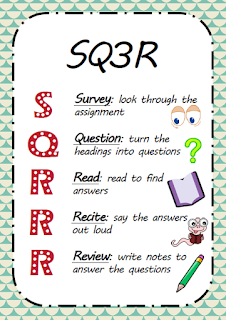SQ3R Method
Francis P. Robinson, an American educator wrote a book titled 'Effective Study' in 1946. In this book he proposed the SQ3R method of studying textbooks. According to him, SQ3R stands for the initial letters of the 5 steps involved in studying a text:
Survey: To survey means to have a quick glance through the title page, preface, chapter headings etc of a text. Through the survey the student can gauge the main ideas of the text. Apart from the author's name, date and place of publication the title page gives an idea of the subject area and the level of focus in that particular text. Whenever a student surveys the index / bibliography the student can easily identify whether the text contains what he / she needs.
Question: The survey that the student does will raise questions in his / her mind regarding the text. Turning to particular chapters / sections in a book trigger specific questions in the mind of the student.
Read: Advocate a critical approach in reading a text. Unless the student does this, the questions that arise in his / her mind will never be answered satisfactorily. Read the matter again and again; each time for a different purpose. Never try to make notes while reading for the first time. During the first reading just look for the main ideas and its supporting details. Underline the key words while reading BUT in the second reading, not in the first reading; in order to concentrate on those parts that are relevant and critical for the purpose with which the student reads it.
Recall: Whatever is read again and again is easily recalled by us. While reading the student must learn to connect what he / she reads with his / her previous knowledge and by relating the text to its future lessons. Students must share their experience in reading with one another to benefit themselves in interpreting a text, drawing inferences and learning to read between the lines. This sharing will help them to find opportunities for reactive reading, for raising problems and concentrate better. Robinson used the term 'recite' instead of recall. He used to tell his students to look away from the book and try to recite the answer s to the questions.
Review: Reviewing means to critically analyse a book in the backdrop of current thoughts and ideas. When a student reviews a text in the final reading, he /she does it with a purpose of checking the validity of all the steps involved in reading - whether one made a proper survey, were the right questions asked, critically read and recall the most relevant issues. Thus in the review stage, repeat all the 4 steps - survey, question, read and recall.
Question: The survey that the student does will raise questions in his / her mind regarding the text. Turning to particular chapters / sections in a book trigger specific questions in the mind of the student.
Read: Advocate a critical approach in reading a text. Unless the student does this, the questions that arise in his / her mind will never be answered satisfactorily. Read the matter again and again; each time for a different purpose. Never try to make notes while reading for the first time. During the first reading just look for the main ideas and its supporting details. Underline the key words while reading BUT in the second reading, not in the first reading; in order to concentrate on those parts that are relevant and critical for the purpose with which the student reads it.
Recall: Whatever is read again and again is easily recalled by us. While reading the student must learn to connect what he / she reads with his / her previous knowledge and by relating the text to its future lessons. Students must share their experience in reading with one another to benefit themselves in interpreting a text, drawing inferences and learning to read between the lines. This sharing will help them to find opportunities for reactive reading, for raising problems and concentrate better. Robinson used the term 'recite' instead of recall. He used to tell his students to look away from the book and try to recite the answer s to the questions.
Review: Reviewing means to critically analyse a book in the backdrop of current thoughts and ideas. When a student reviews a text in the final reading, he /she does it with a purpose of checking the validity of all the steps involved in reading - whether one made a proper survey, were the right questions asked, critically read and recall the most relevant issues. Thus in the review stage, repeat all the 4 steps - survey, question, read and recall.
This method can be used by one and all while studying any text. It helps achieve efficiency in reading and interpreting a text. One is even able to improvise over the wrong reading practices that are followed.




very nice to know reading methodology
ReplyDeleteThanks PK
ReplyDelete